Paper Doll Organizing Carnival: The Inaugural Edition
As I mentioned last time, this post launches a periodic series, the Paper Doll Organizing Carnival, to share a variety of serious and silly, fascinating and quirky blog posts, news stories and other items I hope will be of interest to you.
There’s no dress code for the carnival (no beads, no silly hats), but I should note that one reader was kind enough to send in this Neatorama link for the Paper Pattern Stilettos by Jennifer Collier to help set a stylish tone for this new series.
(Be assured, you’re more than welcome to peruse Paper Doll posts in bunny slippers, if that adds to your delight.)
BRILLIANCE IN ORGANIZING — The Experts
Janine Adams of Peace of Mind Organizing had posted BINGO in late July, and she and I had talked about how the idea of a BINGO board could be used for various organizing purposes, from small business marketing to children’s chores. (My tiny suggestion was that the concept would work for developing healthy meal planning ideas that could satisfy all the adults and kids in the family by letting them submit mix-and-match entre and side dish suggestions.)
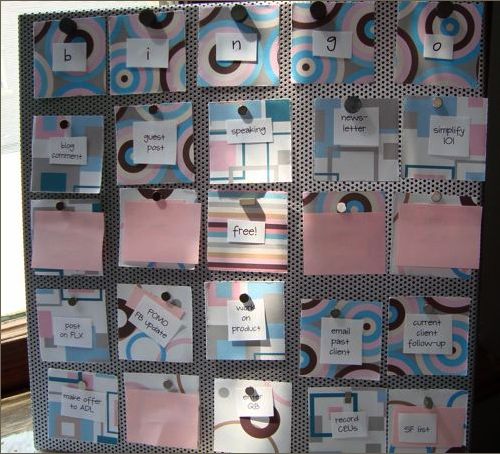
@ 2011 Janine Adams, Peace of Mind Organizing
Janine mentioned that she borrowed the basic idea from Jacquelyn Kittredge’s ebakery for use with accomplishing social media tasks, but applied the framework to To Do tasks, in general. Pretty darn brilliant. The fact that, as we’ve stated before, Paper Doll is not exactly handy, made Janine’s initial post all the more admirable in my eyes. Cutting, glueing? Already above my skill level level.
But then Janine took it a step beyond, consulting with others and coming up with a magnetic version, a foam-board version and even a file-folder version of the BINGO motif. Be sure to check out Janine’s post about how she approached Spreading the Gospel of BINGO via TV, and how she expanded her BINGO paradigm…and made it even prettier.
What about you? How might you organize and motivate yourself using the BINGO method?

As much as I love paper, I find paper alternatives to be ceaselessly fascinating. Almost a year ago, I wrote a post called Morning, Noon and Night: A Day of Fun Alternatives to Paper. From glassware to paint to To Do-themed tattoos, I was tickled by all of the non-paper options at our disposal. I figured this was a meaty enough topic that I might revisit it on a periodic or annual basis. I’d already collected a few items, such as the Write-On Mug, above.
Have you ever read a blog post and thought, “Geez, I wish I’d written that?” That’s a familiar thought to me, whenever I read my colleague Jeri Dansky’s blog. So imagine my glee at reading Jeri’s recent post, Desk Decor: Erasable Notepads and Message Boards. Jeri always manages to find fascinating North American and global resources for the organizing-themed products she showcases, and I have to say, I’m pretty partial to the various write-on dishware from YoYo Ceramics, as well as this nifty notepad:
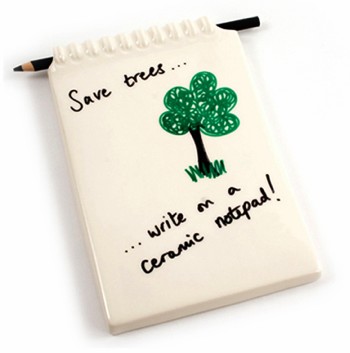
Then again, Jeri’s posts also prompt me to fall in love with items that have nothing to do with paper, but put such a cute spin on organizing that I fall hopelessly in their sway, like this Takae Mizutani Egg & (Toast) Soldiers organizing set:
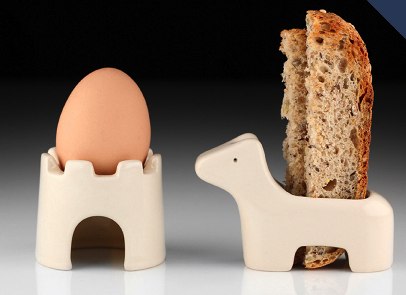
POST-IT PHILOSOPHY
Of course, not every organizing tool is about organizing stuff, tasks or information. Sometimes, it’s important to organize thoughts. I was intrigued by Mark McGuiness’ If It Doesn’t Fit On A Post-It, It Won’t Fit In Your Day at the99percent. His idea? Simply that:
“If I can’t fit the day’s tasks on the Post-It, I’m not likely to fit them into the day.”
Lengthy or abundant To Do lists can easily overwhelm the user, and though there are many ways to deal with tasks (in a BINGO card, via a digital option like Workflowy, or with various other task or reminder apps), sometimes a 3″ x 3″ sticky note is all you need. (Long-time readers will recall that although I eschew random sticky notes, I have, on record, come out firmly in favor of the Revenge of the Floozies.)
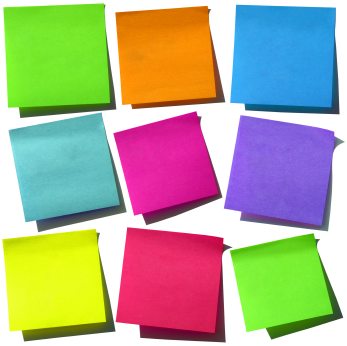
I was particularly intrigued by McGuinness’ approach, with one “top” Post-it for prioritized tasks, and a second sticky note for the secondary task detritus of life, because, as he notes, it’s in line with Mark Forster’s Do It Tomorrow technique. Why? Because I originally learned about time and task management expert Mark Forster last year, from none other than Janine Adams!
IN THE NEWS: ART EMERGENCIES
Andrew Robison has been the Curator of Works on Paper at The National Gallery of Art in Washington, DC for more than thirty years. Robison has been maintaining a rotating collection of watercolors, prints and drawings in a protected storage location. Thus, even though the post Curator Andrew Robison Decides What Goes Into National Gallery’s Emergency Box appeared in The Washington Post last month, it’s an apt and interesting fit for September’s National Emergency Preparedness Month.
As The National Gallery of Art determines which precious paper works go in its “WWIII boxes” (i.e., preserving a percentage of our nation’s masterpieces in case of a World War III-level catastrophe of natural or man-made origins), it’s a good prompt to think about which of your possessions you need to protect in case of emergency. (And don’t forget to make sure you know what kind of insurance coverage you have, and if it’s enough to protect the value of all of your own masterpieces.)
While you’re trying to decide which pieces of your home-based collections are precious, you might want to take a peek at Do You Suffer from Decision Fatigue?, a fascinating New York Times piece on the science of decision-making. I encourage readers who are losing the fight against paring down their possessions (or avoiding snacks at the checkout counter) to read this article and gain a little strength and willpower.
LIBRARY LOVE
Paper Doll is a book lover, which is why this blog sometimes promotes a variety of approaches, from how to downsize and curate one’s library to how to acquire the information contained in books without actually keeping the books, themselves. In that spirit, a variety of book-related blog posts recently intrigued me.
For example, it seems that public bookshelves, like small libraries, have been “sprouting up all throughout Germany”, according to Bookshelf‘s piece on the Rise of Public Bookshelves in Germany.
As DW World also reports, these public bookshelves are giving new hope to old reading treasures in a world of Kindles and Nooks. The concept is less like what we usually think of in terms of quiet, muted public libraries and more akin to those “take a penny, leave a penny” bowls by cash registers in restaurants. Realize you need a good book as you approach a cafe or (as above) bus stop? Take a book. Once finished, instead of letting it collect dust in your living room, return it and take another.
The movement is known by the unfortunate-sounding Bcherschrank (German for bookshelf), and volunteers maintain the collections. The mini-libraries began in indoor locations, like Cologne’s Ikea, but are often now installed in (sponsored) weatherproof outdoor enclosures. Remarkably, vandalism is not an issue.

The Germans haven’t cornered the market on library talk. I first heard about the Little Free Library from Superpunch.
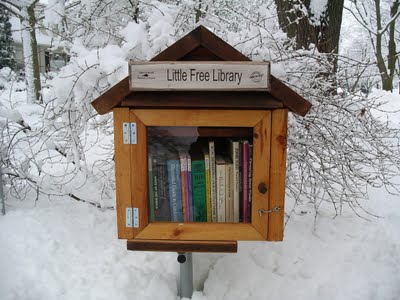
The Little Free Library has an inspiring three-part mission statement:
- To promote literacy and the love of reading by building free book exchanges worldwide.
- To build a sense of community as we share skills, creativity and wisdom across generations.
- To build more than 2,510 libraries around the world–more than Andrew Carnegie!
Each Little Free Library that pops up on the horizon in Wisconsin or Indiana or Minnesota is a “house of stories” just large enough to hold perhaps twenty or thirty books, which might be non-fiction, poetry, novels or even how-to resources.
You can order your own Little Free Library, available in a variety of styles, including the Amish Barn Wood Cabin, above, an Amish Barn Wood Shed, the Classic (with clean, simple lines) or a variety of one-of-a-kind, original art or build-your-own options. Or, you can adopt a library, paying it forward, and help support the movement.
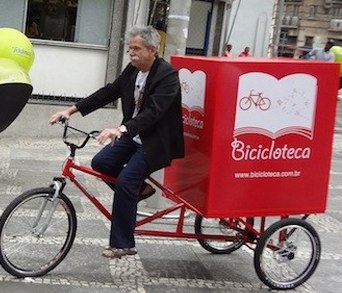
And if one couldn’t get to a library — even a teeny tiny one — a new kind of bookmobile might be in order. As reported by Springwise, Brazil’s Institute of Green Mobility has invested in Bicicloteca, a library made mobile by an adult-sized tricycle, to deliver books to the homeless and other disadvantaged members of society.
MAKING A SHOPPING LIST, CHECKING IT TWICE
Before we sign off on this first-ever Paper Doll Organizing Carnival, I had to note this nifty wood and rubber checklist stamp from Japan’s Pencils.jp, which I

originally found through Book of Joe, a blog which purports to be written by the “World’s most popular blogging anesthesiologist” — a claim one would be hard-pressed to deny.
Until next time, Paper Doll hopes you’ve had a lovely time at the carnival!
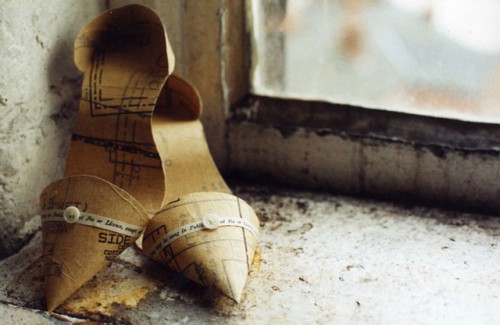





Follow Me